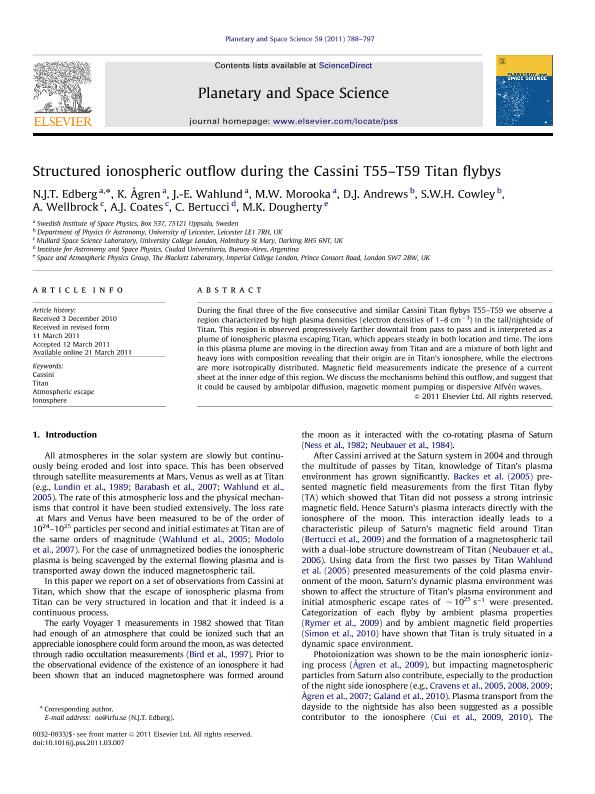Mostrar el registro sencillo del ítem
dc.contributor.author
Edberg, N. J. T.
dc.contributor.author
Ågren, K.
dc.contributor.author
Wahlund, J. E.
dc.contributor.author
Morooka, M. W.
dc.contributor.author
Andrews, D. J.
dc.contributor.author
Cowley, S. W. H.
dc.contributor.author
Wellbrock, A.
dc.contributor.author
Coates, A. J.
dc.contributor.author
Bertucci, Cesar

dc.contributor.author
Dougherty, M. K.
dc.date.available
2017-07-10T17:45:43Z
dc.date.issued
2011-06
dc.identifier.citation
Edberg, N. J. T.; Ågren, K.; Wahlund, J. E.; Morooka, M. W.; Andrews, D. J.; et al.; Structured ionospheric outflow during the Cassini T55–T59 Titan flybys; Elsevier; Planetary and Space Science; 59; 8; 6-2011; 788-797
dc.identifier.issn
0032-0633
dc.identifier.uri
http://hdl.handle.net/11336/19989
dc.description.abstract
During the final three of the five consecutive and similar Cassini Titan flybys T55–T59 we observe a region characterized by high plasma densities (electron densities of 1–8 cm3 ) in the tail/nightside of Titan. This region is observed progressively farther downtail from pass to pass and is interpreted as a plume of ionospheric plasma escaping Titan, which appears steady in both location and time. The ions
in this plasma plume are moving in the direction away from Titan and are a mixture of both light and heavy ions with composition revealing that their origin are in Titan’s ionosphere, while the electrons are more isotropically distributed. Magnetic field measurements indicate the presence of a current sheet at the inner edge of this region. We discuss the mechanisms behind this outflow, and suggest that it could be caused by ambipolar diffusion, magnetic moment pumping or dispersive Alfve´n waves.
dc.format
application/pdf
dc.language.iso
eng
dc.publisher
Elsevier

dc.rights
info:eu-repo/semantics/openAccess
dc.rights.uri
https://creativecommons.org/licenses/by-nc-sa/2.5/ar/
dc.subject
Cassini
dc.subject
Titan
dc.subject
Atmospheric Escape
dc.subject
Ionosphere
dc.subject.classification
Astronomía

dc.subject.classification
Ciencias Físicas

dc.subject.classification
CIENCIAS NATURALES Y EXACTAS

dc.title
Structured ionospheric outflow during the Cassini T55–T59 Titan flybys
dc.type
info:eu-repo/semantics/article
dc.type
info:ar-repo/semantics/artículo
dc.type
info:eu-repo/semantics/publishedVersion
dc.date.updated
2017-07-07T15:20:22Z
dc.journal.volume
59
dc.journal.number
8
dc.journal.pagination
788-797
dc.journal.pais
Países Bajos

dc.journal.ciudad
Amsterdam
dc.description.fil
Fil: Edberg, N. J. T.. Swedish Institute of Space Physics; Suecia
dc.description.fil
Fil: Ågren, K.. Swedish Institute of Space Physics; Suecia
dc.description.fil
Fil: Wahlund, J. E.. Swedish Institute of Space Physics; Suecia
dc.description.fil
Fil: Morooka, M. W.. Swedish Institute of Space Physics; Suecia
dc.description.fil
Fil: Andrews, D. J.. University of Leicester; Reino Unido
dc.description.fil
Fil: Cowley, S. W. H.. University of Leicester; Reino Unido
dc.description.fil
Fil: Wellbrock, A.. University College London; Estados Unidos
dc.description.fil
Fil: Coates, A. J.. University College London; Estados Unidos
dc.description.fil
Fil: Bertucci, Cesar. Consejo Nacional de Investigaciónes Científicas y Técnicas. Oficina de Coordinación Administrativa Ciudad Universitaria. Instituto de Astronomía y Física del Espacio. - Universidad de Buenos Aires. Facultad de Ciencias Exactas y Naturales. Instituto de Astronomía y Física del Espacio; Argentina
dc.description.fil
Fil: Dougherty, M. K.. Imperial College London; Reino Unido
dc.journal.title
Planetary and Space Science

dc.relation.alternativeid
info:eu-repo/semantics/altIdentifier/url/http://www.sciencedirect.com/science/article/pii/S0032063311000948
dc.relation.alternativeid
info:eu-repo/semantics/altIdentifier/doi/http://dx.doi.org/10.1016/j.pss.2011.03.007
Archivos asociados
